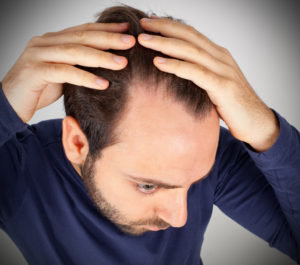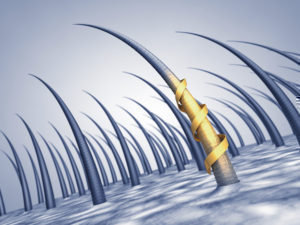Using Finasteride
About male pattern baldness
Male pattern baldness develops when hair follicles are destroyed as a result of DHT (dihydrotestosterone) exposure. DHT is a metabolite that is formed during the conversion of the male hormone testosterone.
Propecia inhibits the conversion of testosterone to DHT and thus can stop or slow hair loss in men and even lead to regrowth over time.
Even though modern folklore and even some limited scientific studies have suggested that the mother’s side of the family is largely responsible for a genetic predisposition toward baldness, the truth of balding is not all mothers’ fault.
In fact, doctors now say baldness patterns are inherited from a combination of many genes on both sides of the family. There are some environmental factors that come into play, too.
It can also be caused by environmental factors like poisoning, radiation, certain drugs, infections, hormone disorders, or nutrition deficiencies. Also, physical stress caused by a sudden weight loss or other physical or emotional shocks can lead to temporary hair loss.

Stages of hair loss
There are many factors that affect the rate at which a man loses hair, but the reason they all tend to shed in this predictable pattern is simple. Male pattern hair loss is caused by hormones and genetic predisposition. After puberty, the level of testosterone increases. One of its derivatives, dihydrotestosterone (DHT), is a key ingredient in hair loss for men who have a family history of hair loss.
Well, the rate at which men lose hair varies enormously. Male hair loss can begin as early as puberty and while some men may shed rapidly in their 20’s up to a Type 3 or Type 4, others may have no detectable amount of hair loss until they are in their 50’s, only to advance to a Type 6 or Type 7 in just a few short years.
Essentially, the scale is used to assess how advanced a man’s hair loss is, the higher the number, the more advanced the loss. And if you start to thin or recede early in life, there’s a good chance you’re destined to lose quite a bit of hair.
- Type I. Minimal hair loss;
- Type II. Insignificant hair loss at the temples;
- Type III. The first stage that requires treatment;
- Type III vertex. Receding hairline and thinning hair on the vertex;
- Type IV. A bigger pattern on the vertex and hairline;
- Type V. Patterns at both sites are bigger but a thin division line is still present;
- Type VI. The bridge is gone but several strands of short fine hair may remain;
- Type VII. The most severe form of hair loss. Little hair on the front or top of the head.
What is Finasteride?
First produced in 1997, 1 mg per day of Finasteride was shown to be beneficial for men with mild to moderate hair loss in a five-year study. Two-thirds of the men who took the medication daily saw some regrowth of their hair, while those who did not take the medication experienced further hair loss. Analysis showed that for all five years of the study, the average hair count remained above baseline among the Finasteride group and was increased compared to those who did not take the treatment. The medication is only effective for as long as it is used, with the therapeutic effects being lost within 6 to 12 months after discontinuation of the therapy.
Finasteride is an anti-androgen agent used to treat benign prostatic hyperplasia and male pattern baldness. Finasteride is sold currently under the brand names Proscar and Propecia.
For most men, Finasteride increases the number of scalp hairs in the first year of treatment, helping to fill in thin or balding areas of the scalp. In addition, men taking Finasteride may note a slowing of hair loss.
Although results will vary, generally you will not be able to grow back all of the hair you have lost. There is not sufficient evidence that Finasteride works in the treatment of receding hairline in the temporal area on both sides of the head.
Mechanism of action
The mechanism of action of Finasteride is based on its preferential inhibition of type II 5a-reductase through the formation of a stable complex with the enzyme.
Inhibition of type II 5a-reductase blocks the peripheral conversion of testosterone to DHT, resulting in significant decreases in serum and tissue DHT concentrations, minimal to moderate increase in serum testosterone concentrations, and substantial increases in prostatic testosterone concentrations. As DHT appears to be the principal androgen responsible for stimulation of prostatic growth, a decrease in DHT concentrations will result in a decrease in prostatic volume (approximately 20-30% after 6-24 months of continued therapy). In men with androgenic alopecia, the mechanism of action has not been fully determined, but Finasteride has shown to decrease scalp DHT concentration to the levels found in a hairy scalp, reduce serum DHT, increase hair regrowth, and slow hair loss.
In fact, 83% of the men who take the medicine have successfully stopped male pattern baldness and kept the hair they already have. And 65% of the men who were using Finasteride even experienced a noticeable regrowth of lost hair over the course of three months.
Finasteride doesn’t completely cure male pattern baldness. Instead, it blocks the hormone linked to hair loss in men (DHT) and is only effective for as long as you take the medication. No matter how successful your treatment is and regardless of how much hair you’ve managed to grow back, if you stop taking Finasteride abruptly, you’re not going to like the result. More often than not, the hair you grew back will fall out and the balding process as a whole will resume where it left off.
Think of Finasteride as a way to put male pattern baldness on pause. Still, it’s an incredibly effective tool in the fight against hair loss and the only prescription treatment approved for male pattern baldness.
Six reasons your hair is falling out
A healthy person loses normally anywhere from 50 to 100 strands of hair per day. But if you notice larger clumps of your mane missing, there might be a bigger problem at hand.
- You are not eating enough protein;
- You are not getting enough iron;
- You are in a high-stress situation;
- You use too many or too often hair products on your scalp;
- You have a thyroid problem;
- You started a new medication.

May I use Finasteride if I’m not balding?
Preventing hair loss by using treatment before you develop any signs of male pattern baldness is an unusual approach. It is also not recommended and potentially unnecessary; although genetic hair loss is hereditary, it does not necessarily affect every member of the family.
While treating hair loss early on can be beneficial, it is not recommended to waste your time and money on preventing baldness before you know if you are affected. It is likely that you will be, but not certain.
What is recommended is to monitor your hair over time, looking for any excessive shedding, drop in the general thickness or receding. You can do this yourself or have a consultation where specialists can keep photos on file for you for a specific period, then, if you start to develop signs of hair loss, that would be the time to seek help. This, rather than using treatment before a confirmed diagnosis, would be the optimum time to start a personalized program designed to stabilize hair fall and promote regrowth.
Can I take Finasteride along with other hair loss treatments?
Currently, on market, there are two approved treatments for male pattern baldness: Finasteride 1 mg and Minoxidil. There are also other products, known as additional hair growth supporting products or dietary supplements.
If you are particularly concerned that you may be losing your hair then a consultation where you can talk directly to a specialist may be useful, even just to put your mind at rest.
First off, you should talk to a dermatologist or hair loss specialist. Aside from doing that, there are a number of things you can do to minimize your risks if you’re considering using Propecia:
- Get a medical evaluation. You could have a medical issue you aren’t aware of, which could jeopardize your safety while on the drug. Getting a full check-up could be a wise move on your part, including some blood and hormonal tests, if possible. Some doctors like to test prostate-specific antigen levels in their patients before prescribing Propecia whereas others offer optional DHT testing to all their patients prior to going on Finasteride, and if they have low DHT levels, they may not recommend it to those persons.
- Proceed with caution if you have a mental health issue. Patients with certain mental health problems may be more likely to notice side-effects.
Before you begin treatment, if you’re having a mental health issue, you may want to talk to a counsellor or therapist, along with your doctor.
How to prevent hair loss?
- Watch what you eat. Lean protein found in fish, lean meats, and soy supports hair growth, and nuts and seeds are packed with vitamin E and healthy fats to provide your hair with the oil it needs to stay soft and healthy. Even spices can help: Adding cinnamon to your food can help provide the necessary oxygen and nutrients to your hair.
- Stay hydrated. Some 25% of your hair follicles are made of water and when you’re dehydrated, new follicles may be weak.
- Take your medicines. Next to stress, genes, and medical issues, vitamin deficiency is a primary reason for hair loss in men. To help prevent balding, get enough vitamins from a well-rounded diet. Vitamin A is helpful in regulating the synthesis of retinoic acid in the hair follicles. Vitamin B can help you reduce your stress levels (a contributor to hair loss) while vitamins C, D, and E help your body maintain the necessary nutrients that it needs to remain healthy.
- Get an expert opinion. Ask a dermatologist how to prevent hair loss and more than likely he or she will tell you to be proactive and work to solve the issue before it starts or gets worse.
- Talk to your doctor about hair loss medications. When it comes to how to prevent balding, several medications and treatments are on the market that may slow or prevent hair loss in men. One of the most well-known is Minoxidil, otherwise known as Rogaine. Rogaine, an over-the-counter foam, has been shown to prevent hair loss and may promote hair regrowth in some. You apply it directly to your head twice daily. It is more efficient at growing the hair back on the crown and less so at the front of your head. Finasteride, or Propecia, is a prescription pill you take daily. It is important to note that both these medications must be used continuously for benefits to last. They are sometimes used in conjunction with one another. Speak to your dermatologist about the best course of treatment for your hair loss.
- Manage stress. Some men may even stress so much about losing their hair that the stress they create leads to additional hair loss. High levels of stress can result in numerous medical hair loss conditions including telogen effluvium (a condition that essentially pushes your hair out of your head), trichotillomania (a man’s urge to pull his hair out of his scalp), and alopecia areata (where your immune system attacks the hair follicles).
- Limit your smoking and drinking. Smoking can be an issue because it impacts the blood flow to your hair follicles while drinking alcohol in excess can cause dehydration and nutritional deficiencies.
- Be active. Exercise is a proven stress reliever and promotes circulation and good health overall, which may encourage hair growth.
How should I take Finasteride?
You may need to take Finasteride by mouth daily for three months or more before you see a benefit from taking it.
Finasteride can only work over the long term if you continue taking it. If the drug has not worked for you within twelve months, further treatment is unlikely to be beneficial. If you stop taking Finasteride, you will probably lose the hair you have gained within 12 months of stopping treatment. You should discuss this with your doctor.
Take Finasteride at the same time each day.
Finasteride can be administered with or without meals.
The recommended dose of Finasteride is one tablet (1 mg) a day.
Safety and efficacy have been demonstrated in men between 18 to 41 years of age with mild to moderate hair loss of the vertex and anterior mid-scalp area.
Pharmacokinetics of Finasteride
The bioavailability of Finasteride 1 mg following oral intake ranges from 26-170% with a mean of 65%. The average peak plasma concentration has been found to be 9.2 ng/ml measured 1-2 hours after administration. The bioavailability of Finasteride is not related to food intake. Finasteride is extensively metabolized in the liver by Cytochrome P450 3A4 enzyme subfamily and excreted both in urine and faeces. The terminal half-life is approximately 5-6 hours in men between 18-60 years of age and 8 hours in men more than 70 years of age.

Side-effects
In general use, the following have been reported: breast tenderness and enlargement; depression; allergic reactions including rash, itching, hives and swelling of the lips and face; problems with ejaculation; testicular pain; and, in rare cases, male breast cancer. You should promptly report to your doctor any changes in your breasts such as lumps, pain or nipple discharge. Tell your doctor promptly about these or any other unusual side-effects:
More Common
- Chills;
- Cold sweats;
- Confusion;
- Dizziness, faintness, or lightheadedness when getting up from a lying or sitting position.
Less Common
- Bloating or swelling of the face, arms, hands, lower legs, or feet;
- Breast enlargement and tenderness;
- Hives or welts;
- Itchy skin;
- Rapid weight gain;
- Redness of the skin;
- Skin rash;
- Swelling of the lips and face;
- Tingling of the hands or feet;
- Unusual weight gain or loss.
Incidence Not Known
- Clear or bloody discharge from the nipple;
- Dimpling of the breast skin;
- Inverted nipple;
- Lump in the breast or under the arm;
- Persistent crusting or scaling of the nipple;
- Redness or swelling of the breast;
- Sore on the skin of the breast that does not heal.
If you are intending to use Finasteride for the first time, or if you have questions related to its side-effects, please address directly to our pharmacy and to our doctor at phone number 0161 707 6800.
References
- https://www.healthline.com/health/male-pattern-baldness;
- https://www.forhims.com/blog/is-Finasteride-the-right-hair-loss-remedy-for-you;
- https://www.rd.com/health/beauty/hair-falling-out/;
- http://www.hairlossdaily.com/propecia-for-hair-loss/;
- Venkataram Mysore. Finasteride and sexual side effects. Indian Dermatol Online J. 2012 Jan-Apr; 3(1): 62–65. PMCID: PMC3481923. PubMed PMID: 23130269. DOI: 10.4103/2229-5178.93496;
- https://www.drugs.com/sfx/propecia-side-effects.html;
- Mrinal Gupta and Venkataram Mysore. Classifications of Patterned Hair Loss: A Review. J Cutan Aesthet Surg. 2016 Jan-Mar; 9(1): 3–12. PMCID: PMC4812885. PubMed PMID: 27081243. DOI.4103/0974-2077.178536.

